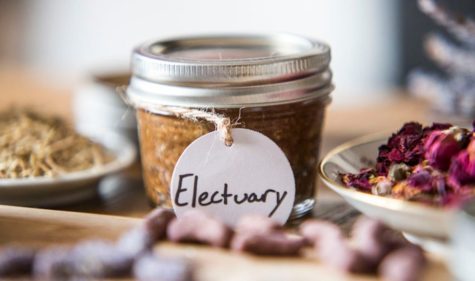Making Honey Powder Pastes
Aside from capsules, there are other ways to take powdered herbs. A honey powder paste, or electuary, is a particularly nice way to take them, and it preserves the herb material very well, too.
Administration and Dosage Guidelines
You can stir the honey powder paste into tea or hot cereal, or just eat it off the spoon. For medicinal effects, take 1 to 3 teaspoons 2 or 3 times per day.
Shelf Life and Storage Guidelines
You can store honey powder paste in a glass jar for a year or more. As with other herbal medicines, it is best to keep it away from heat and light.
Necessary Tools, Equipment, or Ingredients
- Powdered herbs
- Honey
- Small, wide-mouth jars
- Small pot
- Water
- Stove or hot plate
- Labels
Preparing Remedies – Step by Step
Use a ratio of 1 part powdered herbs to 5 parts honey. For example 2 1/2 tablespoons powdered herbs to 3/4 cup honey. You can grind your own, but store-bought powdered herbs will make for a less gritty and smoother texture.
Measure the honey and place it in a jar. It’s best to use a squat, wide-mouth jar as this will also be the container for your finished honey powder paste.
Warm the honey gently by placing the jar in a small pot of hot (not boiling) water on the stove or on a hot plate. Do not let water get into the jar – keep the water level in the pot 1 to 2 inches below the jar’s mouth.
As the honey warms, it will transition suddenly to a thin, watery consistency. When this happens, remove it from the heat and stir the powdered herbs into the honey.
Stir very, very well, making sure to break up any clumps of powder. Continue stirring for a few more minutes after you think it’s all stirred in, so it will not separate or clump up. The paste will thicken as it cools and even more over time.
Close the jar and label it with the ingredients used and the date it was made.
Pros
- Long shelf life. When suspended in honey, the herb material is protected from oxidation and breakdown. Even powdered herbs will maintain their potency for years when they’re preserved in honey.
- Full spectrum. With any powder-based preparation, you get all the water, alcohol, and fat soluble constituents the herb has to offer.
- Delicious. While some don’t like the grittiness of honey paste, the sweetness is very popular.
Cons
- Sweet means sugar. Herbal honey powder pastes are not ideal for those with insulin resistance, diabetes, or other blood sugar regulation problems.
- Gritty. Especially if you grind your own herbs at home, your paste may have a gritty texture that some don’t enjoy. Commercially made herbal powders are much finer and more consistent in texture, and yield a smoother paste.
Additional Considerations
In the Ayurveda medical tradition of India, it’s common to make a similar preparation using ghee (clarified butter). It’s not as sweet, but it can be employed in the same way as a honey powder paste.
Source: Herbal Medicine for Beginners
Rennie Luttrull: queen-annes-lace-seeds
Rosanna: Spignel aka Bald Money
Annamarie Squatrito: Fumitory
EILEEN Klinghagen: Pumpkin
Mahmudul Hasan: Celery



Leave a Reply